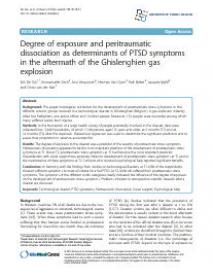Degree of exposure and peritraumatic dissociation as determinants of PTSD symptoms in the aftermath of the Ghislenghien gas explosion.
BACKGROUND:
This paper investigates risk factors for the development of posttraumatic stress symptoms in the different survivor groups involved in a technological disaster in Ghislenghien (Belgium). A gas explosion instantly killed five firefighters, one police officer and 18 other people. Moreover, 132 people were wounded among which many suffered severe burn injuries.
METHODS:
In the framework of a large health survey of people potentially involved in the disaster, data were collected from 3,448 households, of which 7,148 persons aged 15 years and older, at 5 months (T1) and at 14 months (T2) after the explosion. Hierarchical regression was used to determine the significant predictors and to assess their proportion in variance accounted for.
RESULTS:
The degree of exposure to the disaster was a predictor of the severity of posttraumatic stress symptoms. Peritraumatic dissociation appeared to be the most important predictor of the development of posttraumatic stress symptoms at T1. But at T2, posttraumatic stress symptoms at T1 had become the most important predictor. Dissatisfaction with social support was positively linked to development of posttraumatic stress symptoms at T1 and to the maintenance of these symptoms at T2. Survivors who received psychological help reported significant benefits.
CONCLUSIONS:
In harmony with the findings from studies on technological disasters, at T1 6,0% of the respondents showed sufficient symptoms to meet all criteria for a full PTSD. At T2, 6,6% still suffered from posttraumatic stress symptoms. The symptoms of the different victim categories clearly indicated the influence of the degree of exposure on the development of posttraumatic stress symptoms. Problems inherent to retrospective scientific research after a disaster are discussed.
Geachte bezoeker,
De informatie die u nu opvraagt, kan door psychotraumanet niet aan u worden getoond. Dit kan verschillende redenen hebben,
waarvan (bescherming van het) auteursrecht de meeste voorkomende is. Wanneer het mogelijk is om u door te verwijzen naar de bron
van deze informatie, dan ziet u hier onder een link naar die plek.
Als er geen link staat, kunt u contact opnemen met de bibliotheek,
die u verder op weg kan helpen.
Met vriendelijke groet,
Het psychotraumanet-team.
Reference:
E. de Soir, E. Zech, A. Versporten, H. van Oyen, , R.J. Kleber, O. van der Hart, & J. Mylle | 2015
In: Archives of public health, ISSN 0778-7367 | 73 | 1 | 21
http://www.archpublichealth.com/content/pdf/s13690-015-0069-9.pdf
In: Archives of public health, ISSN 0778-7367 | 73 | 1 | 21
http://www.archpublichealth.com/content/pdf/s13690-015-0069-9.pdf


